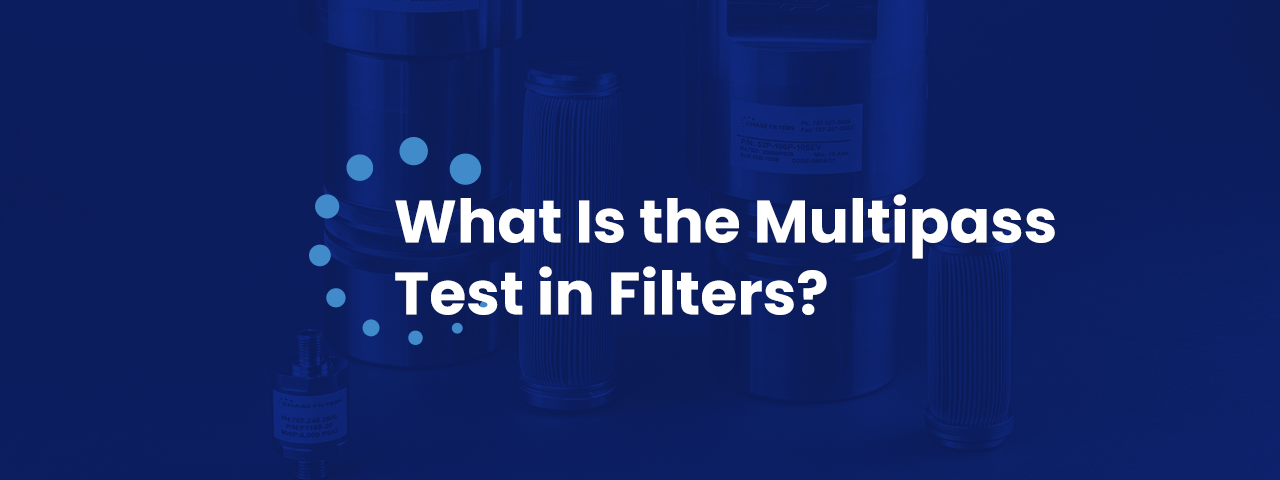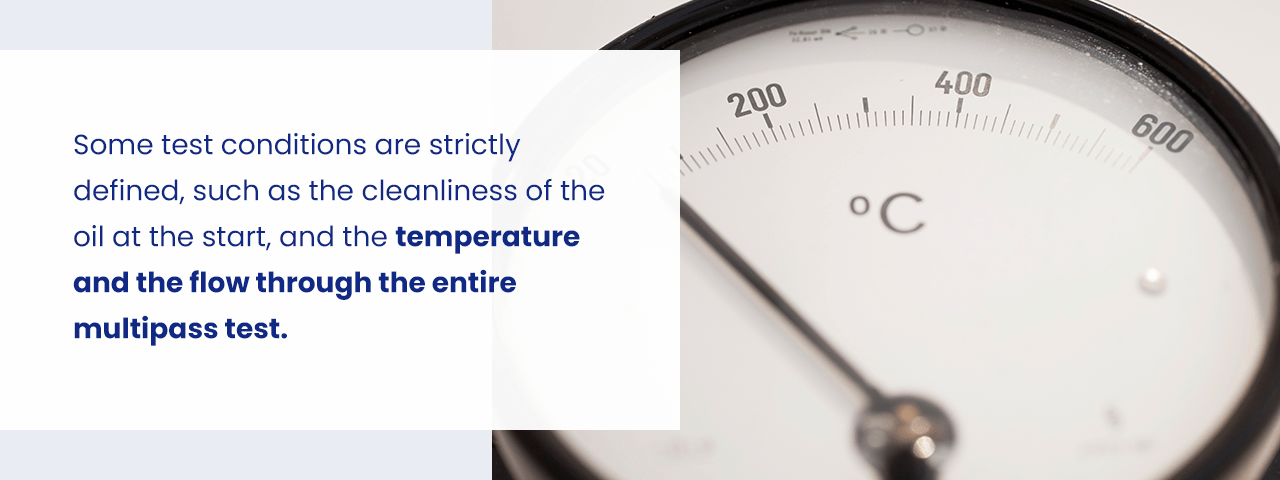January 12, 2024
What Is the Multipass Test in Filters?
Jump To:
During the last few years, there’s been a lot of development and research in filters. One of these developments includes the multipass test.
The multipass test, also known as the beta test, helps generate a more consistent rating for hydraulic filters, allowing you to find a reliable beta ratio, which helps describe the effectiveness of a filter. The beta ratio is starting to replace absolute and nominal ratings that manufacturers once used.
Laboratory testing has created a new way to test pumps and use wear profiles, or graphs, to determine how many contaminates a filter can handle through their life expectancy. Additionally, new filter media is being created with higher dirt retention.
These new developments aim to create a uniform filter rating among manufacturers and encourage more knowledge regarding filter requirements.
What Is the Beta Ratio?
Tradition filter performance is rated using micron (µ) ratings, which indicate the smallest particle size a filter is capable of removing. However, this rating system can sometimes be an incomplete measure of a filter’s performance. Instead, filter ratings should be calculated using the beta ratio, which is derived from the multipass efficiency test.
The beta ratio helps determine the efficiency of filter elements regarding their ability to remove particles of a specific micron size. The beta ratio translates to the quality and efficiency of the filter for particular applications.
For example, say you have 50,000 particles of 10 micrometers or larger counted before the test filter. If 10,000 of these particles are counted after the filter, the corresponding beta ratio would equal 5, which is often read as “Beta ten equal to five.”
On it’s own, a beta ratio number doesn’t mean much. Finding the beta ratio is the first step in the multipass test to determine a filter’s particle capture efficiency. In the example above, the filter tested would be 80% efficient at removing particles of 10 micrometers or larger because 20% of the particles passed through, meaning that for every five particles, four are captured by the filter.
There are various beta values for filters, going all the way up to 50,000, which indicates that the filter can capture 99.9980% of particles that pass through the filter, or only two pass through for every 100,000 particles. Ideally, you’ll want to look for higher beta ratios when using the multipass test to ensure filters can capture as many particles as possible for your applications. You’ll also need to look at the particle sizing for the beta ratio to ensure the filter is useful for your applications.
What Is the Multipass Efficiency Test?
The multipass test is a laboratory procedure that measures and rates filter media in conditions that filter manufacturers can duplicate, similar to the conditions within the field where these filters are used. Because many particles can pass through a filter several times before they’re caught, it’s essential to recirculate the test fluid, gas or air multiple times through the filter.
First, the procedure starts with clean oil or gas before contaminants are added slowly as they would in the field. This process continues until the filter is filled with particles and dirt at the by-pass pressure. While the multipass test can’t wholly define a specific filter’s performance, it does specify two essential areas of a filter’s efficiency at removing particles of various sizes and dirt-loading characteristics.
Some test conditions are strictly defined, such as the cleanliness of the oil at the start, and the temperature and the flow through the entire multipass test. Other conditions of the test are more open-ended, such as flow rate, measuring equipment and the size of the sample.
3 Types of Multipass Tests
There are three different methods of the multipass test to determine the efficiency and dirt-holding capabilities of a hydraulic and lubrication filter. The three types include:
1. ISO 16889 Test
This test is the industry standard for the multipass test. Its primary purpose is to detail the essential aspects of the design and construction of test stands, procedures during testing and the application of contaminants. For example, this test requires that:
- Operators choose the steady flow rate and measure it in L/min.
- The use of ISO medium dust.
- Particle counters must be automatic and correctly calibrated.
- Testing completes once the test filter’s differential pressure has been met, and results must be recorded.
The ISO 16889 test is the easiest to operate and is ideal for repeatability and laboratory testing. As a result, this test is the furthest from real-world examples of how filters interact with contaminants in operating environments. The test also utilizes a steady flow rate, so it doesn’t offer a perspective of how fluctuating flow rates can impact filter performance.
2. ISO/CD 23369 Cyclic Flow Test
This test is proposed to replace the ISO 16889 test, as it includes updates and revisions that make it more likely to replicate real-world applications. Some of these updates include the following:
- Using cyclic flow rates that alternate every five seconds and are measured in L/min.
- The time between automatic particle readings is decreased to every 30 seconds at the operator’s discretion.
- The use of ISO fine dust.
Like the ISO 16889 test, this test concludes once the test filter’s differential pressure is met at the maximum test flow rate, and results must be recorded. While this test is a step closer to real-world applications, it’s essential to note that it can miss crucial data during testing due to infrequent particle counts, such as flow transition.
The results from this test are also averaged rather than specific, which can create a misleading picture of a filter’s performance if the test isn’t performed correctly.
3. Cyclic Stabilization Test
The cyclic stabilization test (CST) shares similarities with the ISO/CD 23369 test, which utilizes the same cyclic flow rates, ISO fine dust and changing flow rates every five seconds. What makes the CST different is:
- Non-constant contaminant feed utilizing an on-and-off method.
- Omitting the first 80% of a filter’s life.
- When particle counting starts and the frequency of when counts are taken, either every 30 or 60 seconds.
Because the CST omits the first 80% of a filter’s life and averages the beta ratio, test results may appear better than they are. The test also uses the same flow rate as the ISO/CD 23369, meaning the test filter doesn’t receive 100% of contaminants throughout the entire duration of the test.
While each testing method has some advantages and disadvantages, they can give you a general idea of how a filter can perform in a real-world setting. The beta ratio and multipass test can help you find a filter with the best application efficiency and performance.
Find High-Quality Filters at Chase Filter Company
If you’re looking for high-quality filters for hydraulic fluid, engine lubricant, air, oxygen, gas, water or fuel, Chase Filter Company can help. We serve numerous industries and manufacture commercial and industrial filters for your applications.
Our experienced team is here to help you solve your challenging filtration needs. Our filter products are quality tested to ensure we can help you solve your filtration challenges. Our products can help save you downtime, maintenance and the cost of repairs or replacements, protecting your components from contamination failure.
Contact us today to learn more about how we can help you find filtration solutions for your industry.


